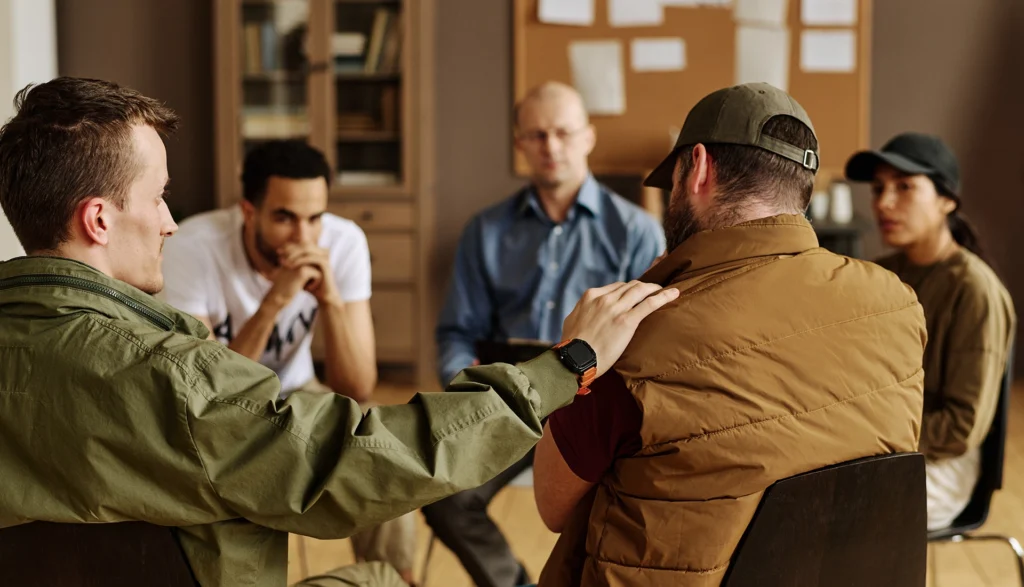Concerned about PTSD? This article outlines the main signs of PTSD, helping you recognize symptoms and seek support. Expect details on intrusive memories, avoidance behaviors, mood changes, and reactivity symptoms.
Key Takeaways
- PTSD symptoms are categorized into four main types: intrusive memories, avoidance behaviors, negative changes in mood and thinking, and arousal and reactivity symptoms, which can emerge shortly after trauma or years later.
- Different age groups exhibit distinct manifestations of PTSD symptoms, with children often showing behavioral changes and teens displaying emotional struggles through risky behaviors, necessitating tailored support.
- Untreated PTSD can lead to serious complications, including mental health issues, physical health problems, and significant disruptions in daily life, highlighting the importance of timely intervention and effective treatment options.
Recognizing PTSD Symptoms
Post-Traumatic Stress Disorder (PTSD) symptoms are categorized into four main types:
- Intrusive memories
- Avoidance behaviors
- Negative changes in mood and thinking
- Arousal and reactivity symptoms
These categories help us understand how profoundly PTSD can affect an individual’s mental and emotional well-being. Symptoms can begin appearing within three months after experiencing the trauma but may also emerge years later. Early recognition of these symptoms can lead to effective treatment and support.
Intrusive memories, including flashbacks, nightmares, and severe emotional reactions, are hallmark symptoms that can cause individuals to experience symptoms of PTSD, vividly bringing the traumatic event back to life.
Avoidance behaviors, where individuals avoid places, people, or activities that remind them of their trauma, can significantly disrupt daily routines and lead to feelings of isolation.
Persistent negative thoughts, feelings related to hopelessness, and difficulty to experience positive emotions can create barriers to enjoying life and maintaining healthy relationships, leading to painful negative emotions.
Arousal and reactivity symptoms can hinder daily functioning and include:
- Trouble sleeping
- Heightened startle responses
- Difficulty concentrating Recognizing these categories and symptoms is key to identifying PTSD and seeking help.
Intrusive Memories
Intrusive memories, such as flashbacks and severe emotional reactions triggered by traumatic memories and distressing memories, can be overwhelming and make it difficult to focus on the present.
In preschool-aged children, intrusive memories might manifest as temper tantrums or physical complaints like stomach aches. Flashbacks, nightmares, or severe anxiety can bring the traumatic experience back to life, hindering progress.
Avoidance Behaviors
Avoidance behaviors are common in PTSD. Individuals may avoid places, people, or activities that remind them of their trauma, which might include steering clear of specific locations, changing daily routines, or avoiding conversations about the event, including eye movement desensitization and avoidance symptoms.
Adults often experience emotional numbness and use avoidance as a coping strategy, significantly impacting daily life and leading to isolation and disconnection from loved ones.
Negative Changes in Mood and Thinking
Negative changes in mood symptoms and thinking are integral symptoms of PTSD. Individuals may struggle with persistent negative thoughts about themselves or the world, feeling emotionally numb and detached from loved ones, leading to isolation and loneliness.
This can result in difficulty experiencing positive emotions and a loss of interest in activities that once brought joy, creating a cycle of ongoing negative emotions that are hard to break.
Arousal and Reactivity Symptoms
Arousal and reactivity symptoms, critical aspects of PTSD, include:
- Trouble sleeping
- Constant tension
- Heightened startle responses
- Angry outbursts
- Difficulty concentrating, which makes it challenging to focus on tasks or maintain stable relationships.
These physical and reactivity symptoms create an environment of constant stress and hypervigilance, further complicating daily life for someone with PTSD.
How PTSD Symptoms Manifest in Different Age Groups
PTSD symptoms can manifest differently across age groups. Understanding these differences is crucial for recognizing and addressing PTSD in children, teens, and adults. Previous trauma, especially during childhood, can heighten the risk of developing PTSD later in life.
Each age group expresses and copes with trauma uniquely, influenced by their developmental stage and life experiences.
Children
In young children, PTSD can manifest through increased clinginess and regression to earlier behaviors like bedwetting. Children aged 5-12 may reenact traumatic events during play, reflecting their experiences and emotional struggles. These behaviors help them process the trauma, even if they can’t articulate their feelings verbally.
Family members should recognize these signs and provide support and reassurance to help children navigate their emotions.
Teens
Adolescents with PTSD may display symptoms similar to adults but with age-specific characteristics. They might engage in risky behaviors, such as impulsivity and aggression, to cope with their trauma.
Teens often express anxiety and sadness through actions rather than words, making it challenging for family members to understand them. Recognizing these behaviors and providing appropriate support is crucial in helping teens manage PTSD symptoms.
Adults
In adults, PTSD symptoms vary widely depending on the types of traumatic events experienced and individual coping mechanisms. Witnessing serious injury or death, or experiencing natural disasters, can lead to a higher risk of PTSD.
Adults may struggle with a combination of emotional responses and coping strategies, making their symptoms complex and multifaceted. Understanding these nuances can help family members provide support and encourage seeking professional help.
Risk Factors for Developing PTSD
Various risk factors contribute to the likelihood of developing PTSD after a traumatic event. Recognizing these risk factors can help identify who might be more vulnerable and why.
After experiencing a traumatic event, about 5% to 10% of people develop PTSD, with 6 out of 100 people experiencing PTSD at some point in their lifetime. The intensity and duration of trauma, individual coping mechanisms, and the presence of social support all play crucial roles in developing PTSD.
Traumatic Event Characteristics
The nature and intensity of the traumatic event significantly influence the likelihood of developing PTSD. Commonly associated events include:
- Combat
- Sexual assault
- Serious accidents
- Natural disasters Similar traumatic events may also contribute to the severity and duration of the event, combined with individual responses, determining its impact.
Recognizing these characteristics can assist in assessing the risk and providing timely support.
Personal History and Genetics
Personal history, including previous mental health problems and family background, plays a significant role in developing PTSD. Genetic predisposition also influences risk, with women statistically more likely than men to develop PTSD.
Considering both personal and family history is important when assessing the risk of PTSD and tailoring support accordingly.
Lack of Social Support
Lack of social support after a traumatic event can significantly increase the risk of developing PTSD symptoms. Minimal support can worsen these symptoms, leading to difficulties in relationships and social withdrawal.
Adequate social support is crucial for mitigating PTSD symptoms and promoting recovery.

Complications Arising from Untreated PTSD
Untreated PTSD can lead to significant complications in various aspects of life. Persistent or worsening symptoms can disrupt daily functioning, relationships, and overall quality of life. Consulting a mental health professional is crucial for individuals experiencing significant disruption.
The longer PTSD remains untreated, the more severe the complications can become.
Mental Health Issues
Untreated PTSD often leads to co-occurring mental health problems like depression, anxiety disorders, and substance abuse, and it often develops ptsd, complicating the emotional response to trauma and increasing the risk of suicidal thoughts and attempts.
Professional treatment for these mental health problems and mental illness is crucial for recovery.
Physical Health Problems
Chronic stress from PTSD can lead to significant physical health problems. The body’s fight or flight response, triggered by norepinephrine, impacts overall health, including cardiovascular issues and a weakened immune system. Despite elevated levels of corticotropin-releasing factor (CRF), cortisol levels in individuals with PTSD can be normal to low, contributing to these physical symptoms.
Impact on Daily Life
PTSD symptoms can significantly impact daily life, causing irritability, concentration problems, and disruptions in workplace stability. Arousal symptoms, like irritability or aggressive behavior, affect relationships and daily functioning, making it challenging to engage fully in life.
Routine activities like grocery shopping or socializing can become sources of ongoing fear, complicating everyday life.
Treatment Options for PTSD
Effective PTSD treatments include psychotherapy, medications, or a combination of both. Early intervention leads to better recovery outcomes.
Treatment typically involves talk therapy and medication, tailored to the individual’s needs and symptoms.
Cognitive Behavioral Therapy (CBT)
Cognitive Behavioral Therapy (CBT) is a primary treatment for PTSD. Forms of CBT, such as Cognitive Processing Therapy (CPT) and Prolonged Exposure Therapy, help patients challenge unhelpful beliefs about their trauma and confront trauma-related memories.
Trauma-focused psychotherapy, often involving talk therapy with a mental health professional, is considered most effective to treat PTSD treated.
Medication
Medications commonly prescribed to manage PTSD symptoms include:
- SSRIs (Selective Serotonin Reuptake Inhibitors), such as sertraline and paroxetine, which are FDA-approved for treating PTSD and help manage sadness, worry, and emotional numbness.
- SNRIs (Serotonin-Norepinephrine Reuptake Inhibitors)
- Prazosin
Working closely with healthcare providers to find the right certain medications and treatment plan is crucial.
Complementary Therapies
Complementary therapies such as acupuncture, yoga, and animal-assisted therapy can aid PTSD recovery. Peer support groups and group therapy offer a space for individuals with PTSD to connect, share experiences, and provide comfort and understanding.
These therapies can be beneficial alongside traditional treatments.
When to Seek Help
Recognizing when to seek help is crucial for managing PTSD effectively. Symptoms must persist for more than a month for a significant PTSD diagnosis. Early intervention leads to better recovery outcomes, so it’s essential to address PTSD symptoms as soon as they become disruptive.
If symptoms significantly disrupt daily life or cause significant distress, consulting a mental health professional immediately is vital. A symptom of such disruption may indicate the need for professional help.
Persistent Symptoms
Persistent symptoms of PTSD, such as intrusive memories, avoidance behaviors, heightened arousal, and other symptoms, should not be ignored. If these symptoms last longer than a few weeks and interfere with daily functioning, seeking help from a doctor or mental health care provider is crucial.
Timely treatment can prevent symptoms from worsening and help individuals gain control over their lives.
Suicidal Thoughts
If an individual experiences suicidal thoughts or self-harm, immediate assistance is necessary. These thoughts can be triggered by the overwhelming feelings and negative emotions associated with PTSD.
Seeking emergency help, such as contacting a crisis lifeline or going to the nearest emergency room, is critical to ensure safety and receive the necessary support.
PTSD is a complex mental health condition that affects individuals differently, depending on factors such as age, personal history, and the nature of the traumatic event. Recognizing the signs of PTSD, understanding the risk factors, and being aware of the complications that can arise from untreated PTSD are crucial steps in managing this condition. Effective treatment options, including cognitive behavioral therapy, medication, and complementary therapies, can significantly improve the quality of life for those affected by PTSD.
In conclusion, awareness and timely intervention are key to overcoming the challenges posed by PTSD. If you or someone you know is experiencing symptoms of PTSD, seeking professional help can pave the way to recovery and healing. Remember, you are not alone—support is available, and recovery is possible.
Frequently Asked Questions
What are the main categories of PTSD symptoms?
The main categories of PTSD symptoms are intrusive memories, avoidance behaviors, negative changes in mood and thinking, and arousal and reactivity symptoms. Understanding these categories is crucial for recognizing and addressing PTSD effectively.
How does PTSD manifest differently across age groups?
PTSD manifests differently across age groups, with children exhibiting clinginess and play reenactment of trauma, teens engaging in risky behaviors, and adults displaying a mix of emotional responses and coping strategies. Understanding these variations is crucial for effective treatment and support.
What are some risk factors for developing PTSD?
The risk factors for developing PTSD encompass the intensity and duration of the traumatic event, a personal or familial history of mental health issues, genetic predispositions, and insufficient social support. Recognizing these factors may aid in prevention and early intervention strategies.
What complications can arise from untreated PTSD?
Untreated PTSD can result in co-occurring mental health conditions such as depression and anxiety, along with physical health issues and severe disruptions in daily life and relationships. Addressing PTSD is crucial to prevent these complications.
What are some effective treatment options for PTSD?
Cognitive behavioral therapy (CBT) and medications such as SSRIs and SNRIs are effective treatments for PTSD, along with complementary therapies like acupuncture and peer support groups. Consider discussing these options with a healthcare professional for tailored guidance.




